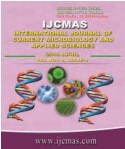


 National Academy of Agricultural Sciences (NAAS)
National Academy of Agricultural Sciences (NAAS)

|
PRINT ISSN : 2319-7692
Online ISSN : 2319-7706 Issues : 12 per year Publisher : Excellent Publishers Email : editorijcmas@gmail.com / submit@ijcmas.com Editor-in-chief: Dr.M.Prakash Index Copernicus ICV 2018: 95.39 NAAS RATING 2020: 5.38 |
Nutrient contents in the leaves of mulberry, Morus alba (L) made it to occupy the pace making place in the sericultural practices. The mulberry, Morus alba (L.) is native to eastern and central China. It became naturalized in Europe centuries ago. The tree was introduced into America for silkworm culture in early colonial times and naturalized and hybridized with the native red mulberry. The red or American mulberry is native to eastern United States from Massachusetts to Kansas and down to the Gulf coast. The black mulberry is native to western Asia and has been grown for its fruits in Europe since before Roman times. It is a flowering, fast growing, woody and perennial plant. Taxonomically, it belongs to the family: Moraceae. Mulberry, Morus alba (L.) gained attention since time immemorial. This is due to its pharmacological and economic value. Use of mulberry leaves in sericulture has been reported in the ancient Chinese literature and therefore well recognized. Therapeutic Significance of Mulberry, Morus alba (L.) have been depicted in the ancient literature through Ayurveda. Some of the ayurvedic therapeutic preparations use fruits, leaves, roots, bark or latex of mulberry, Morus alba (L.) to administer against various human diseases. The raw mulberry fruits, of about 100 g are able to provide 180 kJ (43 kcal), 44% of the Daily Value (DV) for vitamin C, and 14% of the DV for iron; and other nutrients. The health benefits of mulberry, Morus alba (L.) include their ability to improve digestion, lower cholesterol, help in weight loss, increase blood circulation, build bone tissues, and boost the immune system. The fruits of mulberry, Morus alba (L.) also helps prevent certain cancers, slow down the aging process, lower blood pressure, protect eyes, and improve the overall body metabolism. The present attempt is a overview of the major pharmacological properties of Mulberry, Morus alba (L.) along with major applications of phytochemicals purified from it.
 |
 |
 |
 |
 |